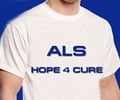Funding for further study in ALS has been generated through the ice bucket challenge that went viral in the summer of 2014.

‘The ice bucket challenge where people dunked a bucket of iced water over their heads, has raised $115m. This amount has funded for an important breakthrough gene discovery, NEK1, in the progressive motor neuron disease, ALS.’





It is often easy to dismiss viral charity campaigns as slacktivism, but a breakthrough discovery bankrolled by 2014’s ALS ice bucket challenge may give the lie to that cynicism. The ice bucket challenge was a phenomenon in the summer of 2014 in which people dunked a bucket of iced water over their heads in order to solicit donations before nominating others to do the same.Scores of celebrities including Mark Zuckerberg,Anna Wintour, Tom Cruise, Charlie Sheen, Robert Downey Jr and hundreds more made videos, but the campaign was criticised by some. The campaign raised more than $100m in a 30-day period, and was able to fully fund a number of research projects. More than 17 million people uploaded videos to Facebook, which were then watched by 440 million people worldwide.
One of these was Project MinE, a large data-driven initiative funded by the ALS Association through ice bucket challenge donations, as well as donations from the organization’s Georgia and New York chapters. The project’s researchers announced that they have identified a new gene associated with the disease, which experts say could lead to new treatment possibilities.
Project MinE has been working to sequence the genomes of 15,000 people with the disease, and the discovery, which was described in a paper published in the journal Nature Genetics involved more than 80 researchers in 11 countries.
“It’s very exciting because it shows everyone who contributed to the ice bucket challenge that their donation had an impact on the research,” said Brian Frederick, executive vice-president of communications and development at the ALS Association. “The work that Project MinE is doing is really important, and the discovery of this new gene will help us better understand ALS.” Brian added.
Advertisement
The discovery was significant, Frederick said, “because it helps us understand what’s triggering this and can help us better find a treatment,” though he added that “it’s still very early in our understanding of this particular gene, and we still have a ways to go with understanding ALS generally."
Advertisement











